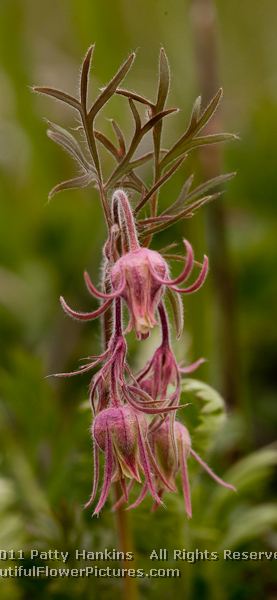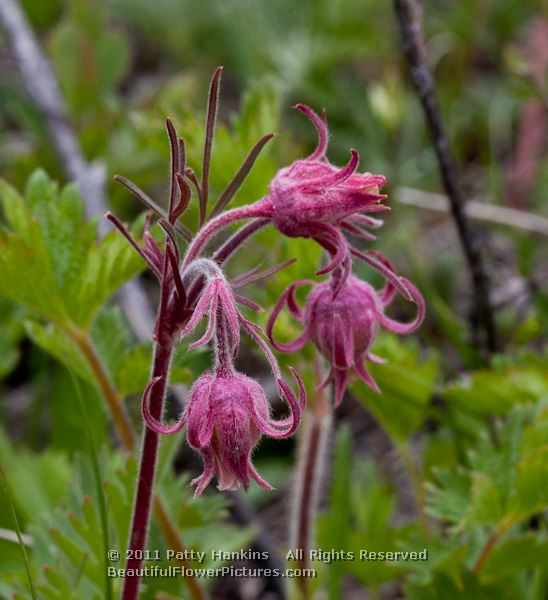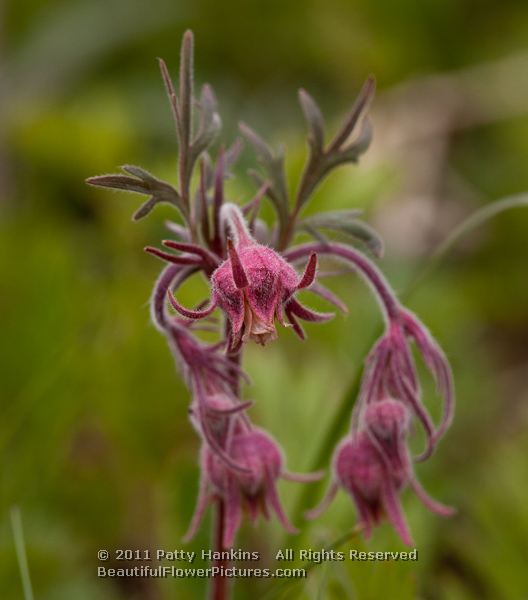by hankinslawrenceimages | Sep 17, 2012 | Flowers, Photo Locations, Wildflowers, Wyoming
Continuing the series of posts with photos that were posted to Facebook while I was on the road this summer . . .
After several days in Glacier National Park, Bill and I headed to Yellowstone National Park in Wyoming. I had visited Yellowstone last summer – and saw lots of snow. Like Glacier – Yellowstone is a completely different place when it isn’t covered with snow!
At Yellowstone – I finally found the western wildflowers I’d heard so much about. In some parts of the park – there were hillsides covered with flowers – in others – there were just a few flowers – but they were also quite beautiful.
Rosy Paintbrush (castilleja rhexifolia) and Silvery Lupine (lupinus argenteus) – and yes I did get asked where was the grizzly bear as I was photographing this set of flowers

© 2012 Patty Hankins
Rosy Paintbrush – Castilleja rhexifolia

© 2012 Patty Hankins
Showy Daisy – Erigeron Speciousus

© 2012 Patty Hankins
Narrowleaf Fireweed – chamerion angustifolium

© 2012 Patty Hankins
Lewis’ Monkeyflower – mimulus lewisii

© 2012 Patty Hankins
I’ll post a few more photos from Yellowstone National Park next week.
by hankinslawrenceimages | Oct 5, 2011 | Flowers, Wildflowers, Wyoming
One of the big surprises of my trip west in June was how challenging it was for me to find wildflowers. After all, it was June – they should be all over the place right! Well not really – it was a long winter so there was still lots of snow on the ground when I arrived in Yellowstone National Park in early June. I spent my first several days at Yellowstone exploring the southern and eastern parts of the park. While the geysers, lakes and river canyons were wonderful – I was getting frustrated by the lack of wildflowers.
Later in the trip, I visited the northern areas in the park – and it was in the Lamar Valley that I found lots of wildflowers. While talking with one of the park rangers about my challenge finding wildflowers – she very nicely explained about the Yellowstone Caldera – which is where all the volcanic and thermal activity in the park takes place. And that one of the characteristics of the caldera region is not great soil condition for wildflowers. So now I know – if I want to photograph wildflowers at Yellowstone – I’m more likely to find them in the non-Caldera region. And I did find some wonderful wildflowers in the Lamar Valley region of Yellowstone National Park!
Here are some of the wildflowers I photographed at Yellowstone National Park.
Arrowleaf Balsamroot – Balsamoriza sagittata – a member of the sunflower family
 © 2011 Patty Hankins
© 2011 Patty Hankins
Meadow Death Camas – Zaigadenus venenosus – a member of the Lily family – and yes – all parts of the plant are poisonous.
 © 2011 Patty Hankins
© 2011 Patty Hankins
Glacier Lilies – Erythronium grandiflorum – another member of the Lily family
 © 2011 Patty Hankins
© 2011 Patty Hankins
Prairie Smoke – Geum triflorum – a member of the rose family
 © 2011 Patty Hankins
© 2011 Patty Hankins
Sugar Bowl – Clematis hirsutissima – a member of the Buttercup family

© 2011 Patty Hankins
Mountain Forget-Me-Not – Myosotis alpestris – a member of the Borage family
 © 2011 Patty Hankins
© 2011 Patty Hankins
Phlox – possibly Rocky Mountain Phlox – Phlox multifloral
 © 2011 Patty Hankins
© 2011 Patty Hankins
I’m thinking about heading back to Yellowstone next summer – and if I do – I’ll definitely plan on spending most of my time in the northern sections of the park.
by hankinslawrenceimages | Oct 3, 2011 | Photo Locations, Wyoming
Talk about a big OOOPPPS!!!! I just realized that I’ve never posted most of my photos from my trip west this summer. These are the photos I edited while on the road to share what I was seeing. So they’ve been posted to Facebook and Twitter – but I never shared them here on my blog. I posted the set from Custer State Park and intended to share the others ones shortly after that and never got around to it. So here’s the first set from Yellowstone National Park – photos from Grand Teton National Park, Glacier National Park and Theodore Roosevelt National Park will be coming soon.
What can I say about Yellowstone National Park that hasn’t already been said? It was incredible. The scenery was amazing. The wildlife was everywhere. And there even some wildflowers. Not as many as I expected – there was still an awful lot of snow at Yellowstone when I was there in June.
My stay at Yellowstone was in two parts – during the first few days of my visit I spent time photographing the landscapes and some wildlife, primarily in the areas of the park with all the geysars and other thermal activity. Here are the photos from that part of the trip.
I spent a few nights at the Old Faithful Lodge which gave me some great opportunities to photograph the Old Faithful Geyser. Since it was right by my hotel, I could choose the time of day and light I wanted to photograph it in. Here’s Old Faithful in the wonderful late afternoon light.
 © 2011 Patty Hankins
© 2011 Patty Hankins
West Thumb Lake is one of the large lakes in the park. Most of it was still frozen when I was there in June – I’ll admit I was surprised to still see so much snow and ice in the park. In places, the snow was still piled higher than my SUV!
 © 2011 Patty Hankins
© 2011 Patty Hankins
Throughout this part of my trip I photographed lots of thermal activity. From geysers to thermal pools, there was always something different to photograph. I particularly liked the way the minerals from the thermal activity created patterns and colorful shapes on the ground. Here are some of the mineral deposits by the edge of West Thumb Lake.
 © 2011 Patty Hankins
© 2011 Patty Hankins
One of the biggest surprises for me was the Grand Canyon of the Yellowstone River. Having visited Grand Canyon National Park last year, I knew what a river could create by wearing away at the rock over time. I just didn’t expect to see anything like that at Yellowstone. I loved this view of the Grand Canyon of the Yellowstone River.
 © 2011 Patty Hankins
© 2011 Patty Hankins
In addition to the incredible landscapes at Yellowstone National Park – there was the wildlife. As most of you know – I don’t do much wildlife photography. It’s not my strength – and really I’d rather just watch the wildlife in it’s natural environment rather than miss seeing it because I’m spending time and effort trying to photograph it. However I did take a few wildlife shots in Yellowstone.
Throughout the park, there are wonderful herds of bison. Here’s a herd relaxing in a field.
 © 2011 Patty Hankins
© 2011 Patty Hankins
Here’s one of the Elk from the Lamar Valley
 © 2011 Patty Hankins
© 2011 Patty Hankins
And finally – a tree swallow. I’m very proud of this photo. Photographing birds is so not my strong point! I have more bad photos of birds, places where birds used to be, birds flying out of the photo, etc than I care to admit. With lots of advice from Dan Williams (my favorite bird photographer) I finally studied a bird’s behavior, realized what spot the bird kept returning to – and set up my camera and tripod focused on that spot. So when the sparrow returned to his favorite landing spot – I was in place and ready to take my photo!!!!
 © 2011 Patty Hankins
© 2011 Patty Hankins
I hope you’ve enjoyed some of my landscape and wildlife photos from Yellowstone National Park. I’ll post some of my wildflowers photos from the park soon.
by hankinslawrenceimages | Sep 21, 2011 | Flowers, Photo Locations, Uncategorized, Wildflowers, Wyoming

© 2011 Patty Hankins
One of my favorite wildflowers I discovered my trip to Yellowstone National Park in June was Prairie Smoke (Geum Triflorum). When I first spotted it – I had no clue what it was – but I knew I wanted to take lots of photographs of it. I couldn’t remember ever seeing a wildflower with the combination of uniquely shaped flowers, fuzzy texture and fascinating leaf structure that reminded me of antlers.
 © 2011 Patty Hankins
© 2011 Patty Hankins
Prairie Smoke, also known as Old Man’s Whiskers and Purple Avens, is a member of the Rose family. Native to much of the Northern and Western United States and Canada, this wonderful wildflower grows to about 18″ tall. It is easily identified by it’s bell shaped fuzzy reddish-purple flowers. After pollination, the flowers turn upward to aid dispersal of the seeds. The flowers are less than 3/4″ wide. The leaves are up to 7″ long and divided into multiple tooted segments.
 © 2011 Patty Hankins
© 2011 Patty Hankins
Prairie Smoke grows easily in many different ecosystems. It can adapt to dry, moist or wet soil – sun, partial shade or full shade. It is often found growing in open woods, mountain meadows and grassland prairies.
 © 2011 Patty Hankins
© 2011 Patty Hankins
Many Native American tribes used Prairie Smoke for medicinal purposes. It was used to treat wounds and coughs. An infusion of the roots was often used to treat sore eyes. It was often given to horses as a stimulant before a race. and the seeds were used to create purfume.

© 2011 Patty Hankins
Prairie Smoke can be grown from seeds or from a division of the rhizome. For the rhizome method of propogation the plants should be split and planted in early spring. Seeds should be collected in late summer, stored for the winter, and then planted in the spring.
More information about Prairie Smoke can be found online at
Burke Museum of Natural History & Culture
Kemper Center for Home Gardening
Lady Bird Johnson Wildflower Center
Michigan Natural Features Inventory
Native American Ethnobotany
Native Plant Network
USDA Germplasm Resources Information Network
USDA Plant Profiles
by hankinslawrenceimages | Jul 17, 2011 | Montana, North Dakota, Photo Locations, South Dakota, Wyoming
| As you may know I spent most of the month of June on an incredible photography trip to some of the state and national parks in North & South Dakota, Wyoming and Montana. I put over 6400 miles on my car, explored wonderful places I’d only heard about before, and took thousands of photographs.
I’m just starting to seriously process my photos from the trip but I thought you might like to see some of my favorites that I edited while I was on the road. I was hoping to photograph some landscapes, wildlife and wildflowers on the trip. And fortunately I found wonderful opportunities to photograph all of them. |
 |
 |
My first stop on the trip was at Custer State Park in Custer, South Dakota. Several photographer friends had recommended Custer State Park as a great place for wildlife. Their wildlife drives are amazing. I saw and photographed my first wild bison and antelope at Custer. I also discovered just how cute (and loud) prairie dogs are! |
| From Custer State Park I headed on to Yellowstone National Park – the oldest park in the National Park System. When you think of the grand parks of the west – Yellowstone immediately comes to mind. The landscapes were incredible and I photographed more wildflowers at Yellowstone than anywhere else on the trip. |
 |
 |
After visiting Yellowstone, I headed south to Grand Teton National Park. This was one of the parks I totally fell in love with and can’t wait to return to. It had everything a photographer could hope to find – wildflowers, wildlife, and incredible landscapes. On one of my hikes I saw four pairs of mother and baby moose. It was at Grand Teton that I found two of the wildflowers I was really hoping to find – Pink Shooting Stars and a Fairy Slipper orchid. |
| Next up was Glacier National Park – where I learned just how late spring can arrive in the mountains of Montana. Going to the Sun Road which goes across the park was still buried under many many feet of snow while I was there in mid-June. The rangers were showing visitors recent photos of the Visitor Center at Logan Pass – where the snow was up to the roof line. I fell in love with the landscapes at Glacier – incredible mountains, glacial lakes and wonderful waterfalls. Next time I head to Glacier it will be later in the summer – in hopes that Going to the Sun Road will be open and I can see more of the park. |
 |
 |
My last stop on the trip was at Theodore Roosevelt National Park. Located in the badlands of North Dakota – one of the highlights of the park was the wild horses roaming the landscapes. It was while visiting this part of North Dakota in the 1880s that Theodore Roosevelt began to become aware of issues such as conservation and the need to protect species from extinction. Later as President of the United States, Roosevelt oversaw the protection of close to 230 million acres of public lands. |
| I, for one, am very grateful to visionaries such as Theodore Roosevelt. The lands protected in our National Parks, Wildlife Refuges and Forests are a treasure for all of us to enjoy. Had earlier generations not preserved these lands for us – we would not be able to enjoy them today.
Photos in the article are
Avalanche Creek – Glacier National Park
Bison – Custer State Park
Prairie Smoke – Yellowstone National Park
Shooting Stars – Grand Teton National Park
Bear Grass – Glacier National Park
Wild Horse in the Fog – Theodore Roosevelt National Park
Barn on Mormon Row – Grand Teton National park |
 |






























